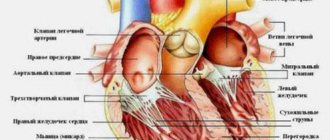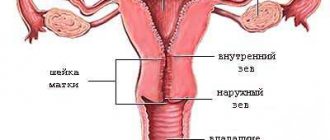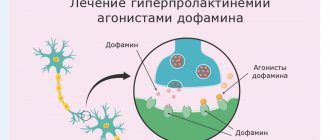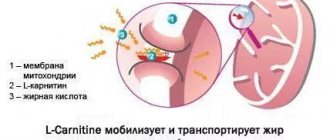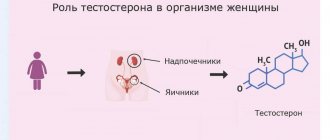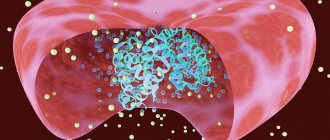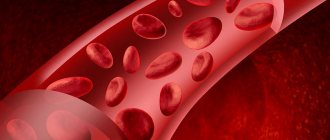Progesterone is a hormone that is activated in the female body during gestation and phase 3 of the menstrual cycle. Its biological role is quite large, so it has diagnostic value.
The level of the hormone is constantly changing, but its high values may be the result of pathology or a normal physiological process.
Why can women have increased progesterone and what does this mean?
Don't self-medicate! Be sure to consult with a qualified healthcare practitioner. The information is for informational purposes only and does not replace medical care.
What is it responsible for, how to find out its level
Progesterone is initially formed in the adrenal glands and in the corpus luteum of the ovaries, preparing the woman’s endometrium for conception or menstruation.
Its activity increases in the luteal phase of the menstrual cycle, when the corpus luteum begins to form in the ovaries, which intensively produces the hormone.
During this period, the uterus prepares for pregnancy , and if this does not happen, bleeding begins (menstruation). The corpus luteum disappears, and the hormone decreases sharply.
If the egg is fertilized, then progesterone begins to increase, the placenta is formed, which also produces it.
The action of progesterone is responsible for the full gestation of the fetus and the onset of menstruation. This is an essential pregnancy hormone, as it promotes the intrauterine development of the baby.
Main functions of progesterone:
- changing the endometrium of the uterus for further fertilization;
- an increase in the mucous layer of the fallopian tubes, necessary for egg division;
- preparing the mother's body for pregnancy;
- promoting the onset of lactation;
- change in the size of the mammary glands;
- influence on the development of necessary organs and tissues of the fetus;
- suppression of the mother's immunity in order to prevent biological rejection of the child.
Progesterone is important not only during pregnancy , but also during the period of rest of the uterus. It ensures the proper functioning of the mammary glands and prevents the development of mastopathy.
Its secondary role is in the development and formation of the pelvic organs, normalization of blood viscosity, etc.
Progesterone levels are very easy to check . To do this, you need to donate venous blood on days 22-23 of the menstrual cycle. It is in phase 3 of the cycle that its activation occurs.
Laboratory research is carried out by immunoassay (ELISA), which accurately allows you to calculate the concentration of the hormone.
Such diagnostics can be carried out in any public or private clinic.
Progesterone levels change throughout the menstrual cycle, so your doctor will usually do several tests.
This allows you to accurately identify pathology, since the concentration of progesterone is constantly changing physiologically.
You can find out what the norm of estradiol should be in women and what this hormone is responsible for in the female body on our website.
Our article contains information about what the free testosterone index should be in women and what to do if it is low.
Why can androstenedione be elevated in women? Read about the causes and treatment of increased rates here:.
Low progesterone
If there is not enough progesterone produced, the menstrual cycle is disrupted, and women who want to become pregnant often experience problems conceiving or early miscarriages. Moreover, low concentrations of this hormone can be detected even in apparently healthy women.
A decrease in progesterone levels occurs for a number of reasons:
Also, low progesterone levels may be due to the fact that you incorrectly determined the day of your cycle.
However, low concentrations may have more serious reasons:
Signs of low progesterone levels:
If a woman is planning a child, she must understand that with reduced progesterone, pregnancy will not occur in the vast majority of cases or the risk of spontaneous abortion will be very high.
Low progesterone levels can be corrected. Doctors recommend starting treatment 2–3 months before the planned conception. This is hormone replacement therapy, that is, the woman is recommended to take hormones. Moreover, such treatment is also possible throughout pregnancy to reduce the risk of miscarriage. In addition, it is necessary to review your diet to stimulate the natural synthesis of hormones. You should add dairy products, protein, and nuts to your diet.
To normalize progesterone levels, you must first identify and eliminate the cause of the decrease in its concentration. If a woman is already expecting a child, the search for the cause is postponed until after childbirth.
Reasons for the increase
Doctors call an increase in the hormone in the blood serum hyperprogesteronemia. This can be either normal or pathological. You need to immediately understand what day of the menstrual cycle the test was taken. The table shows the approximate norm according to the phases of the menstrual cycle.
| Phase or day of the menstrual cycle | Level, nmol/l |
| Phase 1 (follicular) | 0,30 — 2,27 |
| Phase 2 (ovulation) | 0,50 — 9,43 |
| 3 phase (luteal) | 6,94-56,65 |
The lowest progesterone values are recorded during the postmenopausal period (no more than 0.65 nmol/l), so the disease at this age is very dangerous.
Taking oral contraceptives slightly increases the hormone. But usually a slight increase in numbers is not a pathology, but just a physiological process.
We can talk about existing diseases only if hyperprogesteronemia is recorded in the 3rd or all phases of the cycle.
The cause of such a clinical picture may be the following conditions and/or diseases:
- pregnancy;
- pathological bleeding from the uterus;
- prolonged absence of menstruation;
- cysts of the pelvic organs or corpus luteum;
- malignant neoplasms of the ovaries and uterus;
- renal or liver failure;
- abnormalities in the functioning of the adrenal glands;
- pathologies in the formation of the placenta.
When hyperprogesteronemia is detected, the doctor must prescribe additional diagnostics. It is selected based on the patient’s symptoms and complaints. Most often, an increase in the hormone means pregnancy. But, if a woman is sure of the opposite, then the doctor needs to find a medical explanation for this condition.
Some hormonal, antitumor drugs (Corticotropin) cause a temporary increase in progesterone. Canceling their use restores hormonal levels, but more often they are needed to treat other diseases.
References[edit | edit code]
- John R. Lee, MD Hormone Balance for Men.
- Allen W. M. (1935). "The isolation of crystalline progestin." Science
- John R. Lee, MD What Your Doctor May Not Tell You About Menopause: The Breakthrough Book on Natural Progesterone.
- Johnson WS, Gravestock MB, McCarry BE (August 1971). “Acetylenic bond participation in biogenetic-like olefinic cyclizations. II. Synthesis of dl-progesterone". J. Am. Chem.
- Uzzi Reiss, MD, OB-GYN. Natural Hormone Balance for Women: Look Younger, Feel Stronger and Live Life with Exuberance.
Maintenance during pregnancy and after childbirth
During gestation, progesterone physiologically increases , starting in the first trimester of pregnancy. This is a normal phenomenon, which indicates that there are no intrauterine abnormalities.
Hyperprogesteronemia gradually increases according to the established time limits.
If in the 1st trimester progesterone levels can reach 470 nmol/l, then in the 3rd trimester the levels increase to 770 nmol/l. This is not a pathology, but the maturation of the placenta , which produces progesterone.
Low numbers are much more dangerous , especially at the beginning of pregnancy, as this can lead to miscarriage. However, extremely significant hyperprogesteronemia during pregnancy is also not the norm.
This indicates pathological changes in the placenta, which can increase the size of the uterus or cause complications for the fetus (hydatidiform mole). This condition can be corrected medicinally with drugs; for this you need to immediately consult a doctor.
No one excludes the individual characteristics of the body, since hormonal levels during pregnancy are constantly changing. It is not at all necessary that all indicators will exactly correspond to the reference values.
Gonadotropin ratio
LH and FSH are in a close, complex “inverse” relationship with gonadosteroids, sex hormones produced by the ovaries. A decrease in estrogen concentration stimulates the pituitary gland to produce FSH and LH. Therefore, when gonadosteroid production is low, gonadotropin levels increase.
For the productive activity of a woman’s reproductive system, not only the level of gonadotropins is important, but also the ratio of LH and FSH, which changes depending on the phase of the cycle. In the follicular phase, the concentration of FSH is higher, in the luteal phase - LH. The LH to FSH ratio is normally 1.5-2. If the ratio of gonadotropic hormones exceeds 2.5, this is regarded as a pathological deviation.
If the ratio of LH and FSH is not normal, this may indicate the following disorders:
- pituitary benign tumors;
- PCOS;
- endometriosis;
- dysfunction of the hypothalamic-pituitary complex;
- premature ovarian failure;
- obesity.
If the ratio of LH to FSH is disturbed for a long time at high levels of luteotropin, then activation of the ovaries leads to increased production of androgens.
This disrupts the ovulatory process and negatively affects the menstrual cycle, which becomes irregular. Ultimately, an incorrect ratio of LH to FSH can lead to impaired fertility and infertility. When the ratio of gonadotropic hormones is less than 0.5, the maturation of the egg and primordial follicles is disrupted. The ratio of LH towards a stable increase in the FSH hormone may be a sign of menopause.
Symptoms and signs
Symptoms of high progesterone in women vary widely.
Sometimes a woman feels healthy or does not pay attention to the clinical manifestations of the disease.
Symptoms indirectly depend on the causes and provoking factors that caused the increase in the hormone.
In medical practice, the following manifestations of hyperprogesteronemia are usually encountered:
- depression or neurosis;
- depressed state;
- chronic fatigue and fatigue;
- lowering blood pressure;
- pain in the lower abdomen;
- absence of menstruation or irregular cycles;
- migraine;
- the appearance of acne on the face and body (acne);
- pain in the chest;
- sudden weight gain;
- intestinal problems.
All symptoms can be observed with other abnormalities. Therefore, it is difficult for a doctor to immediately determine the cause of poor health . In such situations, careful diagnosis and examination is required.
During pregnancy, such clinical manifestations are considered normal , but sometimes they indicate the presence of a disease. Typically, the symptoms of hyperprogesteronemia appear in aggregate, and in rare cases they may be absent.
It is easier to recognize this pathology when there are gynecological signs of the disease. Typically, a woman with high levels of progesterone cannot become pregnant or experiences irregularities in her menstrual cycle.
Normal levels of gonadotropins
The secretion of FSH and LH is characterized not so much by a circadian rhythm (daily) as by an hourly rhythm (circhoral). Their level depends on the time of day, phase of the cycle, woman’s age, and estrogen production.
| Age period, cycle phases | Reference (average) values of FSH, IU/ml | Reference values of LH, IU/ml | Estradiol reference values |
| Girls before puberty (up to 9 years) | 0,11-1,6 | 0,7-1,3 | |
| Teenage girls (12-16 years old) | Up to 3.5 | ||
| Women of reproductive age (up to 40 years), follicular phase | 2,8-11,3 | 1,1-11,6 | 57-226 pg/ml |
| Ovulatory phase | 5,8-21 | 17-77, ovulatory peak – up to 150 | 127-476 pg/ml |
| Luteal phase | 1,7-9,0 | 2-17 | 77-226 pg/ml |
| Menopause | Up to 150 | 0,03-3,9 | |
| Postmenopause | 21,7-153 | 11,3-40 |
TSH remains stable - 0.4-4.0 µIU/ml, prolactin - 400-1000 IU/l.
Why are high values dangerous?
Long-term hormonal imbalances can cause significant harm. Increased progesterone is no exception.
Hyperprogesteronemia causes complications and other diseases , which are then quite difficult to treat. The most dangerous are tumors and cysts of the pelvic organs.
With such an advanced hormonal disorder, an ovarian corpus luteum cyst is usually diagnosed.
This is a benign neoplasm that is formed as a result of the accumulation of fluid in the ovarian tissue. The cyst begins to intensively produce the hormone, so its high concentration is found in the blood serum.
This pathology can be successfully treated with drugs , and in rare cases, surgery is possible. In the worst case scenario, it may rupture, but this is an uncommon occurrence in clinical practice.
Dangerous consequences are malignant tumors, but they occur very rarely. These include lipid cell neoplasms or chorionepithelioma, which forms during pregnancy or after childbirth.
However, such serious pathologies account for only 1-3% of all gynecological diseases.
Hyperprogesteronemia can also manifest itself in the urological field. Adrenal dysfunction or kidney failure are possible consequences of late consultation with a doctor. Each person has an individual body, so it is impossible to say exactly what the consequences will be.
The mechanism of occurrence of some diseases has not yet been studied. In advanced cases of hyperprogesteronemia, the following clinical manifestations are possible:
- ovarian corpus luteum cyst;
- malignant and benign tumors;
- diseases of the adrenal glands, including oncology;
- renal failure;
- infertility;
- cirrhosis of the liver;
- obesity.
All of these diseases can be treated with medication and surgery. But the main thing for the patient is not to start the pathological process. Early consultation with a doctor will avoid many complications and symptoms.
Symptoms of hormonal imbalance
The following symptoms indicate testosterone deficiency in men:
- The functions of the reproductive system are impaired. Reduced libido, prostate adenoma and other genitourinary diseases were diagnosed.
- Bone fragility increases and osteoporosis develops.
- Obesity appears, characterized by the appearance of extra pounds in the abdominal area.
- The work of the heart is disrupted, blood pressure rises, and blood circulation worsens.
- Nervousness, high fatigue, general weakness, low endurance.
- Low concentration.
- Pale and sagging skin, increased hair loss, alopecia.
- High cholesterol levels, development of diabetes mellitus.
- General deterioration in health, appearance of muscle pain.
Which doctor should I contact if the hormone is elevated?
Hormonal problems are traditionally dealt with by endocrinologists , who can accurately diagnose endocrine pathologies and conditions.
Regular gynecologists and gynecological endocrinologists deal with hormonal imbalances in the female reproductive system.
These are specialized specialists who can treat both reproductive and endocrine diseases at the same time.
They work in any public and private clinic, so there is no problem finding such a doctor. When hyperprogesteronemia is detected, a thorough diagnosis is carried out in order to determine the causes of this condition.
No doctor will blindly prescribe medications, because otherwise the treatment will be ineffective. The list of diagnostic procedures includes the following studies:
- analysis of venous blood for other hormones of the reproductive system (prolactin, testosterone, LH, estradiol, FSH, cortisol, ACTH, aldosterone, etc.);
- blood biochemistry;
- clinical blood test;
- general urine analysis;
- Ultrasound of the pelvic organs, kidneys, adrenal glands, abdominal cavity;
- colposcopy;
- MRI or CT examination of the pelvic organs, kidneys, adrenal glands.
The results of all examinations and procedures performed allow us to create a complete clinical picture.
It will be easier for the doctor to navigate the selection of the necessary medications and treatment methods, since each woman has her own reasons for the increase in hormonal levels.
In such a situation, an individual approach and treatment is necessary , since there are no unique drugs aimed only at eliminating the pathology.
On our website you will also find a detailed table with prolactin levels in women by age, and you will also find out what functions it performs in the body.
Do you know that an increased number of lymphocytes in a woman’s blood can signal various types of malfunctions in the body? Find out more details here: .
About the causes of hormonal imbalance
In young men, the causes of hormonal disorders are associated with the following factors:
- The functioning of the thyroid gland, pituitary gland, testicles or other glands responsible for the production of hormones is disrupted. Failures can be caused by congenital pathologies or acquired anomalies.
- The gonads stopped producing hormones normally due to bruises, tumor processes, and exposure to infectious pathogens.
- Toxic effects of aggressive liquids, household chemicals and cosmetics.
- Antisocial lifestyle, alcohol or drug addiction, heavy smoking.
In older men, the main causes of androgen deficiency lie in the fact that the function of the gonads decreases, as a result of which less testosterone is produced. At the same time, the amount of estrogens (female hormones) increases and obesity develops. A vicious circle is formed when a decrease in androgens leads to obesity, which increases the synthesis of leptin (the hormone of adipose tissue), which further inhibits the synthesis of testosterone.
Note! Drinking large amounts of beer often leads to hormonal imbalances.
Regardless of age, disruption of hormone production may be associated with the following factors:
- poor physical activity;
- cardiovascular diseases;
- kidney pathologies;
- elevated cholesterol and glucose levels;
- poor nutrition;
- obesity;
- frequent stress, insomnia, chronic fatigue;
- overheating of the testicles (including with cryptorchidism).
Treatment and its features
Significant hyperprogesteronemia in non-pregnant women requires medical adjustment.
If a woman’s progesterone is higher than normal, the gynecologist individually, based on test results, selects a treatment regimen.
Initially, it all depends on how the elevated hormone manifests itself and what complications there are. If the cause is an existing disease, then the main efforts should be directed towards its treatment.
The following methods are used to reduce progesterone levels:
- drug therapy;
- surgical intervention;
- diet;
- physiotherapy.
Drugs that can lower the hormone belong to a variety of pharmacological groups. The most commonly used pills are oral contraceptives , which contain a specific combination of hormones. They suppress the action of progesterone and lower its level.
Contraceptives Yarina, Zhanin, Diane-35, Anteovin can be used as a treatment for hyperprogesteronemia. Synthetic analogues of the hormone estriol, which are no less effective in correcting the hormone, have also proven themselves well.
Epostan (progesterone inhibitor) significantly eliminates the manifestations of hyperprogesteronemia. Therefore, it is often prescribed by doctors to correct hormonal levels. In some cases, gynecologists prescribe medications such as Mifepristone, Tamoxifen, Clomiphene , etc.
All of these drugs should not be taken during pregnancy because they can cause spontaneous abortion and intrauterine complications.
Usually a woman has to treat the underlying disease that caused the increase in progesterone.
If an ovarian corpus luteum cyst has been detected, the basis of treatment will be routine diagnostic observation or anti-inflammatory therapy.
In many clinical cases, oral contraceptives are also used , which are prescribed by a doctor. In severe stages of the disease, surgical removal of the cyst or resection of the ovary is performed if there are additional pathologies.
Malignant tumors that intensely produce the hormone must be surgically removed along with the ovary. The woman is then treated with anticancer drugs and chemotherapy.
If the pathology is caused by nephrotic diseases (adrenal dysfunction, renal failure), then special medications are used that restore the function of the kidneys and adrenal glands. For adrenal pathology, corticosteroid hormones are prescribed , the dosage of which is prescribed by the doctor.
For kidney diseases, the doctor prescribes anti-inflammatory therapy. In any case, the doctor first diagnoses the patient, prescribes additional examinations and tests, and then individually selects a treatment regimen.
Folk remedies
The suggested remedies for lowering progesterone are listed for informational purposes. They can be used as an adjunct to a doctor's prescription, but not as a primary treatment.
Popular recipes for symptoms of excess progesterone:
- Mint and rowan tincture. For the tincture, use rowan flowers and mint leaves, which can be dried. 1 tbsp. l. plants are poured with 1 glass of boiling water. Within 30 min. The remedy is infused. 1 glass is taken in 3 equal portions per day, after meals.
- Rowan tincture. 2 tbsp. l. berries (frozen or fresh) pour 0.5 liters of boiling water. When the drink has cooled, drink it within 1 hour.
- Carrot seeds. For 40 gr. seeds you will need 3 cups of hot water, preferably just boiled. The product is infused in a dark place for 24 hours. One serving is taken during the day, 1 glass.
- Dried cloves. For 10 gr. spices use 1 cup boiling water. Leave for 30 minutes. Then the infusion is filtered and drunk in equal portions 4 times a day.
- Rowan flowers, 1st method. Two teaspoons of flowers are poured into 1.5 cups of boiling water. Leave for 1 hour. Strain and take during the day in 3 equal portions.
- Rowan flowers, 2nd method. As in the previous recipe, you will need 2 teaspoons of flowers. Place them in a saucepan and add 1 glass of water. Bring to a boil, simmer for 15 minutes. Take the decoction 1 day in advance, dividing it into 2-3 servings.
The course of therapy with folk remedies is longer than medication. Also, there is no guarantee that it will help if progesterone is high. Women who prefer traditional methods of treatment focus on their own well-being, determining when it is time to stop taking tinctures or decoctions. Unfortunately, this method is ineffective. Expecting an improvement in well-being, a woman may encounter a placebo. In normal treatment, the health status is assessed by repeat blood tests.
Diet
The clinical manifestation of the disease is sudden weight gain. Therefore, dietary nutrition plays an important role in the treatment and restoration of hormonal levels . It is necessary to strictly limit the consumption of protein foods, which slightly increase the hormone.
Protein foods include:
- cottage cheese;
- milk;
- cheese;
- beef meat;
- seeds;
- legumes;
- nuts;
- flour products;
- rice.
Eating these foods will not immediately increase progesterone levels, as they do not directly affect progesterone production. But there is an indirect effect on hormonal synthesis.
Foods rich in protein and cholesterol activate processes in the body that stimulate hormonal increases. In this case, it is advisable to consume carbohydrates (peas, potatoes, carrots, parsley, beets, onions).
Fruits and dried fruits are also beneficial for hyperprogesteronemia . They contain many vitamins and nutrients. Decoctions of red rowan, mint, and cloves are effective in restoring hormonal levels.
During pregnancy, it is not necessary to adhere to such a diet , except for the strict recommendations of a doctor who knows the clinical picture of the expectant mother.
But diet therapy is an auxiliary means of correcting the disease. This does not in any way replace the main treatment, which should play a major role in normalizing hormonal levels.
Treatment of hormonal disorders in men
In each specific case, treatment is selected individually. Main methods of therapy:
- Stimulating methods that promote increased hormone production. Therapy is carried out until the level of androgens rises to a certain concentration. To do this, the patient is prescribed medications that improve the functioning of the testicles and other sex glands, as well as organs involved in the exchange of male hormones (the prostate gland and liver). Chorionic gonadotropin helps correct the disruption of hormone production. This gonadotropic hormone activates the synthesis of sex steroids. Vitamins, plant extracts and synthetic drugs are used for stimulation.
- Hormone replacement treatment. For a certain period of time, patients take drugs containing testosterone. There are many hereditary diseases of the endocrine glands, in which normalization of male hormones is possible only through the systematic use of drugs. There are hormonal imbalances in which men begin to take testosterone drugs for life.
- Surgical intervention. In some cases, removal of provoking factors – cysts, tumors, etc. – helps eliminate hormonal deficiency.
The choice of treatment method is influenced by a number of factors:
- reasons that caused hormonal imbalance;
- testosterone level and personal characteristics of a man;
- the patient's age and general health;
- the presence of chronic ailments and concomitant diseases.
For young men, treatment with stimulant drugs is optimal. After the recovery course, hormonal imbalances disappear, and the sex glands begin to work at full strength. For genetic pathologies of the genitourinary system and in older men, only replacement therapy can eliminate androgen deficiency. For older men with hormonal imbalances, testosterone preparations are prescribed for life. There is no need to be afraid that regular intake of androgens will cause harm to your health. It has been proven that these are small risks compared to those ailments that develop with low testosterone levels.
To eliminate androgen deficiency, not only medications are used, but also herbal remedies and traditional medicine recipes. Such drugs can only be prescribed as an addition to the main treatment. Dosages of drugs and duration of therapy should correspond to the age of the man.
Important! Before using traditional methods, you should consult an andrologist or endocrinologist about existing contraindications and adverse reactions.
Normalizing testosterone levels is beneficial for the whole body:
- vital energy appears, well-being improves;
- nervousness and irritability disappear, the man becomes more confident;
- concentration and performance are restored;
- weight loss;
- muscle mass increases, bone tissue becomes denser;
- sleep improves;
- hormonal treatment reduces the risk of developing cardiovascular complications, diabetes and arterial hypertension.
The combination of hormonal correction and the right lifestyle works wonders. In men, not only the level of androgens is restored, but also the aging process slows down. The effectiveness of treatment can be assessed by comparing the dynamics of clinical symptoms 1, 2 and 3 months after treatment. In most cases, hormonal disorders disappear and clinical manifestations disappear.
Recommendations for the treatment period
- Avoid excessive physical and psycho-emotional stress.
- Eat a balanced diet, remove flour products, strong alcohol, fried and fatty foods from the menu.
- All doctor's recommendations must be followed.
- Physiotherapy and massage courses help speed up treatment.
- Consult a doctor promptly if alarming symptoms appear.
If hormonal imbalances are not treated, then there is a high risk of developing male infertility, atherosclerosis, myocardial infarction, diabetes and other serious complications.
Are there any warning signs of hormonal imbalances? First, contact an endocrinologist, undergo a thorough examination and get tested. Come to the CELT clinic, competent doctors work here and there is the necessary equipment for accurate diagnosis. No queues and affordable prices.
You can seek diagnosis and treatment at the CELT clinic. Modern equipment, qualified doctors, advanced treatment methods. In one place you can take all the tests and immediately make an appointment with an endocrinologist. It is very easy to be healthy with the doctors of the multifunctional clinic CELT.
Make an appointment through the application or by calling +7 +7 We work every day:
- Monday—Friday: 8.00—20.00
- Saturday: 8.00–18.00
- Sunday is a day off
The nearest metro and MCC stations to the clinic:
- Highway of Enthusiasts or Perovo
- Partisan
- Enthusiast Highway
Driving directions
